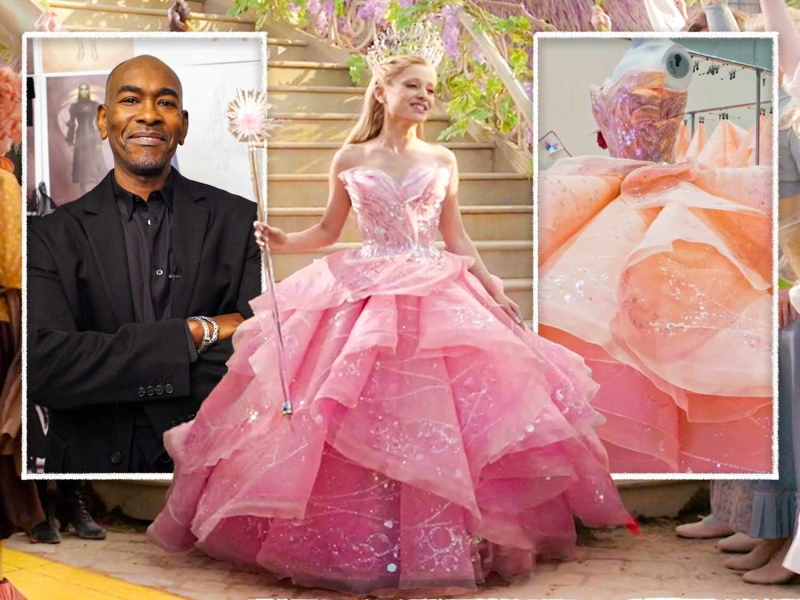Costume designer Paul Tazewell spared no detail in bringing Elphaba and Glinda to life through their clothing.
As he was preparing to start work on the film adaptation of Wicked, Paul Tazewell came across a French picture book about a princess meeting her prince. Those characters weren’t what caught the costume designer’s attention, though. Instead, he kept getting lost in what was happening in the background of the illustrations. “There was this whole other world that was surrounding it,” he recalls now.
That’s what he wanted for Wicked: that a viewer could pause any scene and admire every single element that went into creating the frame. Especially, in his case, the costumes. Because so much did go into creating them—the pink bubble dress Glinda (Ariana Grande) is most known for, for example, is made from 137 pattern pieces and its bodice alone took 225 hours to hand-bead; Cynthia Erivo’s wardrobe as Elphaba, meanwhile, is textured using felting, giving it an organic, from-the-earth feel, a nod to the fact that she is a grounding presence for Glinda.
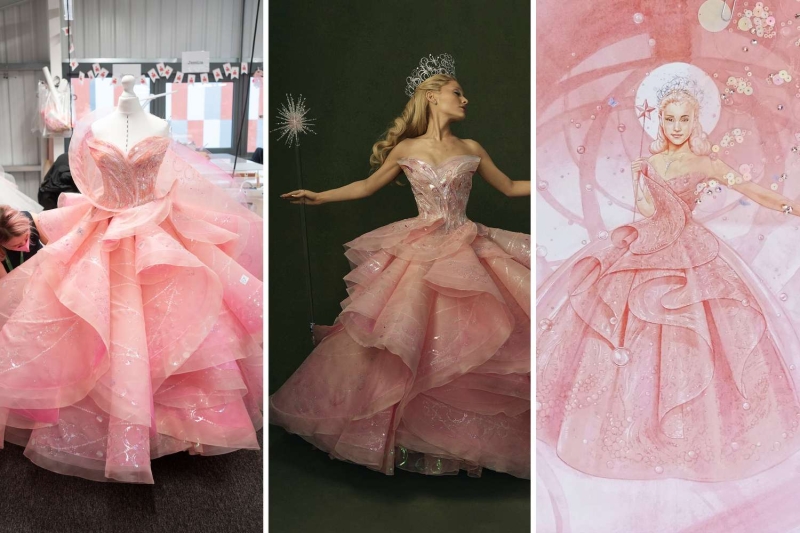
Although Tazewell has more than three decades of experience designing costumes for Broadway (he earned his first Tony nomination for Bring in ‘Da Noise, Bring in ‘Da Funk in 1996), “my love of detail is so much more apparent with film than it is necessarily with theater,” he says. (It’ll probably come as no surprise to learn that Tazewell is a Virgo.)
His previous film and television projects actually have connections to Wicked. His first television gig was designing NBC’s The Wiz Live! in 2015 (for which he won an Emmy), and his first film project was 2019’s Harriet, starring Erivo. Tazewell’s first encounter with the Broadway show Wicked came by way of the costumes themselves. Before he ever saw the production, he would pass by them at the “shops” (a.k.a. ateliers) used by all Broadway costume designers. By the time he did make it inside the Gershwin Theater, he was blown away with how Susan Hilferty interpreted these familiar characters through fashion while putting her own stamp on them. So, when he was officially on board with the movie, he called her.
“Because I had seen the costumes in the shops, I had a good sense of how they were built. And I had seen them in action, so I understood what her potential intention was. I just wanted to say that I was in awe of what she’d set up and that I was going to be sharing my own interpretation of how I saw Wicked,” Tazewell recalls. The stage show leans a bit dystopian, as does the Gregory Maguire novel on which it is based. But the film crew decided not to go as strongly in that direction. “[Director] Jon [M. Chu]’s choice was to re-envision what the world was.”
Interestingly enough, Tazewell had been in Hilferty’s position himself. He designed the costumes for In the Heights on Broadway. (It was his first collaboration with Lin-Manuel Miranda; they would reunite on Hamilton years later, for which Tazewell won a Tony.) But, when the musical was adapted for the big screen—by Chu—Mitchell Travers did the wardrobe, linking it back to Tazewell’s work.
Tazewell spent eight months before heading off to the U.K. to film researching, developing ideas, and “really sussing out how Jon was imagining us telling this story and then figuring out what this world might possibly be.” He had a lot of source material to pull from: the Broadway show, the 1995 novel, the seminal 1939 film The Wizard of Oz, and the 1900 book by L. Frank Baum that started it all.
The stage production and the Judy Garland–led movie have such strong, established, recognizable visuals—audiences would likely be walking into the theater with an image of these characters and this world in their minds. Luckily, that’s a challenge Tazewell had faced (and aced) before: He was the costume designer on Steven Spielberg’s West Side Story, and received Academy Award, Critic’s Choice Award, and Costume Designers Guild Award nominations for his work.
Going into Wicked, Tazewell says he felt more confident than he would’ve a few years prior, before West Side Story. “Wicked overall is daunting, because you're establishing and creating this whole world of Oz. I had approached West Side Story [loving] the original film and the design that Irene Sharaff had created for that version. [Going through that process] required that I investigate internally the way that I see [the story] as a designer and as a fan. What are those moments that really excite me? What are those moments that I think are really perfect in how Irene Sharaff originally conceived of that film?”
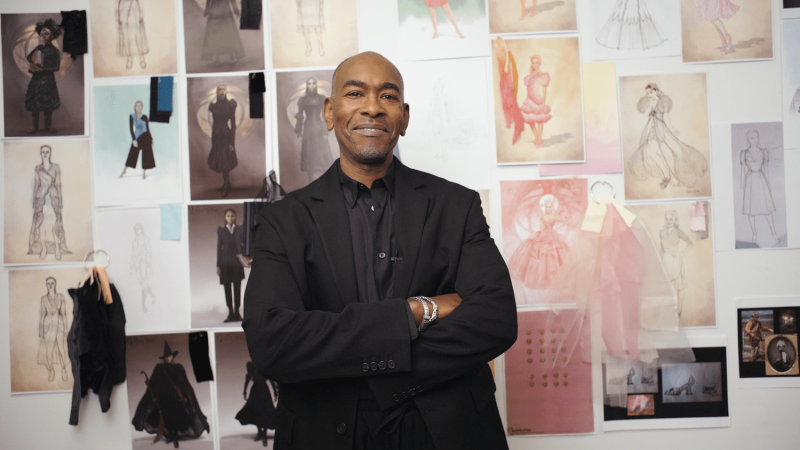
For Tazewell, it wasn’t about recreation, nor was it about reinventing the wheel: Success lies in identifying those key looks, then being able to “digest how I experience them and see them through my lens and how I might reimagine what that same energy and life force looks like.”
Of course, there are many differences between West Side Story and Wicked. The most crucial one for Tazewell being that “West Side Story is set in a very specific group of years…. Wicked is a completely made-up world. It could be anywhere.”
“Again, it's thinking: What are those icons that people are relating to and will remember from the original movie and then also from Broadway?,” he continues. “It's always going to be Glinda’s arrival in the bubble.” Hilferty expressed the idea of the bubble with a very sparkly blue dress. For the film, Tazewell “decided to really grab hold of the idea of Billie Burke’s pink dress [from The Wizard of Oz] and then reimagine what that might be for a modern audience and a modern eye. Our version has a vaguely similar silhouette. It gives you the same energy, but it's completely reimagined and updated.”
Tazewell began his work by compiling lookbooks to help build and articulate the visual identity of the Ozians. Looking back on those now—years after he started working on them—it strikes him how some things stayed the same. “Not necessarily designs, per se, from foot to head,” he says, “but the energy of whatever that idea was.”
One such element is the Fibonacci Spiral, which was an early concept for Glinda’s wardrobe. “I had that as an image, then it’s represented in some Escher prints that I found and also in some other architectural and kaleidoscope imagery,” he says. “[Production designer] Nathan [Crowley] was, separately, looking at similar styles and designs. There was a simpatico that seemed perfect, but we were working in two different locations at two different times.”
Tazewell also understood that, narratively, their color palettes were established. “Elphaba is going to be dark because she needs to be seen as evil, and Glinda is going to be light because she needs to be seen as the good one.” Tazewell’s concern, then, was adding depth, as well as backstory.
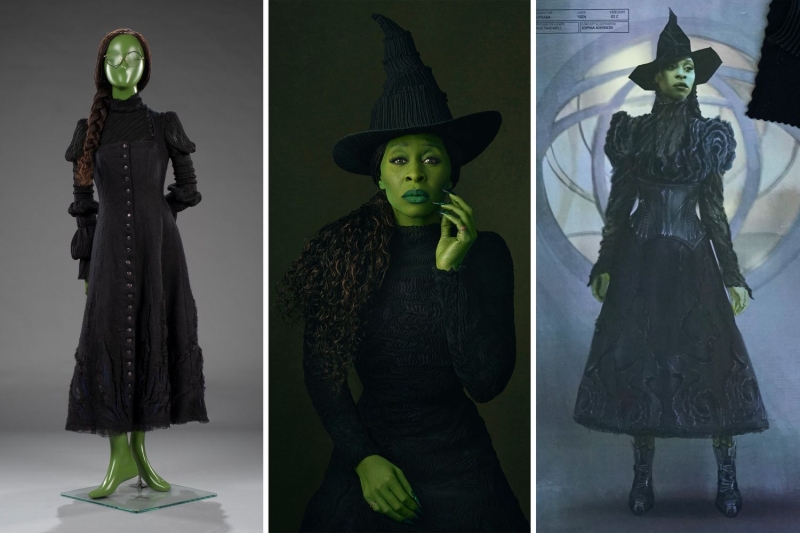
“Why was Elphaba in black? [We had] to think about the austerity of black, thinking about teenagers and young adults who make that decision to pull away from society and revert to that,” he says. “Her mother died very early in her life, and then she was ostracized from the family because of the color of her skin. It was giving her reasons to gravitate to that color that was so dark and actually physically kept her outside of the world of the rest of the community.”
Many of Erivo’s costumes aren’t true black, but rather a combination of very dark colors that are “a representation of black,” says Tazewell. (The skirt of Elphaba’s Ozdust Ballroom dress, for example, is actually an ombré that goes from black to purple.) A lot of storytelling happens through texture, largely inspired by nature. There are callbacks to the Fibonacci spiral (subtly connecting Elphaba and Glinda), with a lot of the patterns drawing from fungi, particularly the underside of mushrooms, which alludes to Elphaba’s connection to nature.
Silhouette was an important medium through which to communicate, too. For much of the first film, Elphaba is seen in a turn-of-the-20th-century shape (a subtle nod to the original Baum story), with puffed sleeves, a big skirt, and a tight waist. It positions her as austere and rigid—a foil to Glinda’s feminine, 1950s-inspired dresses, which Tazewell describes as having a sensibility of “suspension of things in air, butterflies and bubbles and general effervescence.”
However, as a friendship blossoms between the two, their preferred shapes seem to oh-so-slightly blend together. The characters are still visually distinct, but audiences can see how they’ve impacted each other.
“As Elphaba realizes who she is more clearly and what her own internal power is, she becomes more comfortable in her body and starts to expand her wardrobe.” Her clothing has a restrictive quality at the start, “that then moves into kilts and trousers with kilts, her variation of her uniform. She's becoming more agile as we move through her story.”
In a similar way, Glinda “goes from being very perfect and feminine and fussy to—when we get to her look for going to Emerald City—those two silhouettes are matching. They’re a matching pair, but opposites in color and still reflective of who each of them is,” Tazewell explains. “The importance was to show how each of them has affected the other and created this bond that then allows one to make a choice to fly off and basically find herself and the other one to stay put and play by the rules,” he continues. “My hope is that I’m subtly underscoring what's going on with each of them individually and each of them emotionally.”
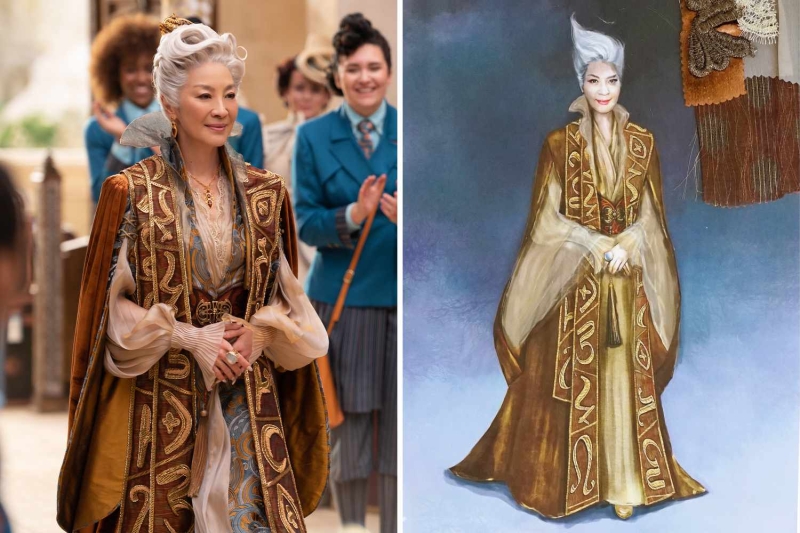
To create these intricate and intentional looks, Tazewell led a costume crew of 140 people, including 70 artisans, working across eight workshops: dyers, fabric printers, hand embroiderers, machine embroiderers, hand knitters, machine knitters, weavers, milliners, leather workers, even 3D printing experts. Over the course of both films, the two female leads each had 60 costumes made for them. Glinda has 25 total looks and Elphaba, 24. (Some ensembles required duplicates.) Michelle Yeoh’s Madame Morrible wears 12 outfits across both movies. It’s a scale of working that’s unique to the big screen, and part of what drew Tazewell to film in the first place.
“For me, it’s another step in how I would like to be able to express myself creatively,” he says. “I've been very, very fortunate over the 34 years I've been designing costumes professionally. Within those 34 years, I've had an amazing, vast array of styles of projects—the opportunity to design Shakespeare, August Wilson, all kinds of musicals from Ain't Too Proud to The Color Purple to On the Town to Guys and Dolls, the Met [Opera] and large ballet companies. What film offers is a larger scope for me to be able to manage design, whether it's with Harriet and the expanse of matching the land with the slaves that are working the land and telling that very, very important story about Harriet Tubman, or West Side Story and how the picture is painted from scene to scene and can be a part of the orchestration that's playing underneath it and the choreography that we're seeing in front of us.”
The world of Wicked is expansive, almost infinite. The collaboration between Tazewell, Chu, Crowley, and every single person on the credit sheet has created something so vivid, so imaginative, so rich, so fun—you almost want it to move slower, to delight in every detail and wrinkle, from the background actors to Jonathan Bailey’s Fiyero boots. Just as Tazewell intended.

